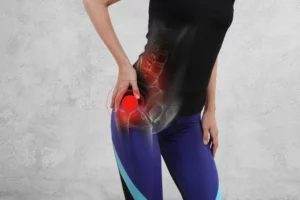Do your baby’s hips click when you carry them?
Have you noticed an uneven thigh or buttocks crease when changing diapers? Does one leg look shorter or feel stiffer than the other? Is your baby limping when starting to walk?
If you have noticed any of these issues in your baby, then they might have Developmental Dysplasia of the Hip (DDH), commonly known as “clicky hips.” An assessment with one of our Paediatric Physiotherapists can help assess, diagnose and manage this condition.
Hip dysplasia in infants
Hip dysplasia in infants is an abnormal development of the hip joint where the bones of the hip joint (femoral head and acetabulum) are not developed properly. This may be a congenital issue or develop during infancy.

Babies at higher risk for hip dysplasia include:
- Family history of hip dysplasia
- Breach position in the womb
- More common in females than males
- Firstborn baby
- High birth weight
How is hip dysplasia diagnosed?
Hip dysplasia is often picked up during routine examinations of the hip in infants. From there an ultrasound scan (under 6 months old) or x—ray (older than 6 months old) is performed to confirm the diagnosis. There is a wide spectrum of presentation of hip dysplasia, ranging from mild to severe. Early diagnosis and management are recommended for best results and to prevent any long-term complications.
Management of hip dysplasia
Management will depend on the age of the child and the degree of hip dysplasia.
Management can include:
- Monitoring – ‘Wait and see’ approach if a mild condition
- Bracing – i.e. Pavlik harness, Rhino
- Surgery – if it is categorised as severe based on the scan
Tips for Healthy Hips
- Baby carriers: The International Hip Dysplasia Institute encourages ‘Hip-healthy’ baby wearing and infant carriers for infants at risk of hip dysplasia. The Institute recommends the infant be carried with their legs in a ‘M’ position to support healthy hip development.

- Swaddling: It is recommended by the International Hip Dysplasia Institute that when swaddling babies you should wrap the blanket tightly around the top part of their body so that the baby feels secure while keeping the legs in a slightly flexed and abducted position so the legs are free to move. You should not wrap the legs in a tight, straight position as this can alter proper development of the hip joint. (International Hip Dysplasia Institute, 2022)
If you are concerned about your baby’s hips, book in a review with one of our Paediatric Physiotherapists today on 9907 0321.


